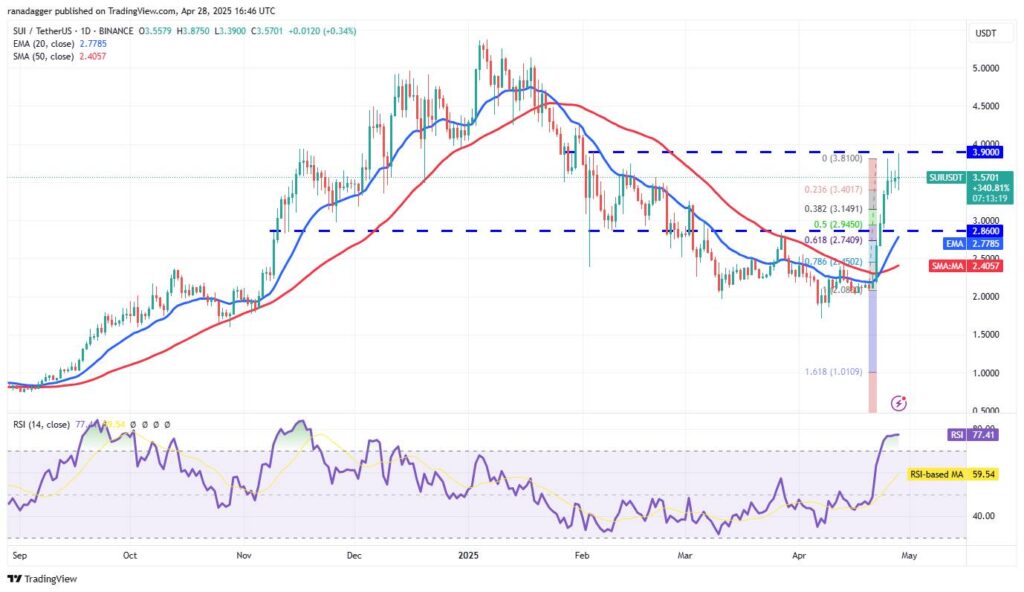In the ever-evolving world of cryptocurrency, Bitcoin is currently facing a key challenge as it hovers around a significant resistance level of $95,000. Despite piercing this point briefly on April 28, sustaining these higher levels has proven difficult, with bears actively defending this critical threshold. However, a silver lining for bullish investors is the relatively stable positioning of Bitcoin, which may enhance the chances of a breakthrough towards the coveted $100,000 mark.
Adding to the positive momentum, there has been a notable surge in institutional demand for Bitcoin, evidenced by impressive inflows of $3.06 billion into U.S. spot Bitcoin exchange-traded funds last week. While such inflows have previously been associated with short-term price peaks, this is not a guaranteed trend, indicating that the overall market sentiment remains cautiously optimistic.
“Increasing market liquidity could catapult Bitcoin to $180,000 before the summer of 2026,” suggested hedge fund founder Dan Tapiero, highlighting the potential for significant future growth amid macroeconomic shifts.
As we take a broader look at the crypto landscape, select altcoins are beginning to show early signs of a trend change, signaling that the momentum may not be confined to just Bitcoin. Crypto enthusiasts are closely monitoring the charts of the top ten cryptocurrencies, aiming to pinpoint essential levels for buying opportunities or impending corrections.
This critical juncture for Bitcoin and the cryptocurrency market as a whole is heightened by the latest dynamics in related financial markets, including the S&P 500 Index and the US Dollar Index, each reflecting broader economic signals that could impact investor behavior in the digital asset space.
Key Points on Bitcoin and Cryptocurrency Market Trends
The current trends in Bitcoin and the broader cryptocurrency market can significantly impact investors and traders. Understanding these points can help readers make informed decisions.
- Bitcoin Resistance Level:
Bitcoin (BTC) is encountering resistance at $95,000, but the bulls have not given up ground.
- Positive Institutional Demand:
Institutional interest is increasing with $3.06 billion in net inflows into US spot Bitcoin ETFs.
- Potential Price Breakout:
Should BTC close above $95,000, it may open up new rally possibilities toward $100,000.
- Market Sentiment Indicators:
Some altcoins are showing signs of a trend change, indicating potential investment opportunities.
- Federal Reserve Impact:
Dan Tapiero’s expectations of increased market liquidity could drive Bitcoin to as high as $180,000 by mid-2026.
- S&P 500 and US Dollar Index Trends:
The S&P 500 shows signs of recovery, while the US Dollar Index has recently retreated, which could influence market behavior.
These factors are interconnected, making it crucial for readers to monitor market conditions, as they could have direct implications for their investment choices.
Recent Trends in Bitcoin and Altcoin Market Dynamics
In the current cryptocurrency landscape, Bitcoin is uniquely positioned as it grapples with the critical $95,000 threshold. While there’s a palpable sense of anticipation regarding a potential surge toward $100,000, the prevailing indecision among investors is palpable. This resistance point presents a variety of opportunities and challenges not only for Bitcoin but also for various altcoins. Unlike traditional financial markets, where stocks may exhibit linear trends, Bitcoin’s volatility invites speculation and strategizing by both retail and institutional investors.
Comparatively, the inflow of $3.06 billion into Bitcoin exchange-traded funds (ETFs) signifies a resurgence of institutional interest. This marks a notable contrast to other trending sectors, wherein high ETF inflows sometimes presage market corrections. Therefore, while institutional backing presents a competitive edge for Bitcoin, it also raises the stakes; should the price plateau or decline, these inflows might heighten investor anxiety. Investors are left weighing the impact of institutional activity against the backdrop of recent macroeconomic forecasts, such as those by hedge fund managers predicting lofty prices of $180,000 for Bitcoin by mid-2026.
On the altcoin front, promising signs of trend reversal are emerging, particularly as select tokens exhibit early bullish sentiment. This dynamic fuels interest among traders looking for higher returns outside of Bitcoin’s shadow. For instance, Ethereum’s slight uptick above its moving averages indicates potential for growth, albeit tempered by resistance levels that could hinder momentum. Similarly, Solana’s strength in bouncing from its recent lows reflects not only resilience but also the possibility that altcoins might carve out niches amid Bitcoin’s stagnation.
However, the potential challenges for altcoins are significant. As Bitcoin remains the crypto market’s bellwether, it can overshadow other assets. A swift downturn could send ripples through the altcoin space, catching less robust currencies off guard. The delicate balance that altcoins face — gaining traction while relying on Bitcoin’s performance — highlights the risks. A spike in Bitcoin’s price could pull altcoins upward, yet if the top cryptocurrency falters, many altcoins could experience significant declines, leading to exacerbate market volatility.
From an investor’s perspective, those focusing on Bitcoin could indeed benefit from its impending breakout, particularly benefitting traders who can navigate this volatile terrain effectively. Conversely, less experienced players might find themselves trapped in a market that swings dramatically based on Bitcoin’s performance. Furthermore, the current demand for altcoins may attract investors who are more risk-tolerant, but the uncertainty surrounding Bitcoin could pose a deterrent for those who prefer stability.
As the cryptocurrency market evolves, understanding the intricate connections between Bitcoin’s performance and altcoins will be essential. Market watchers should keep a keen eye on price movements and institutional behavior as they shape trading strategies in such a fluid environment.

















